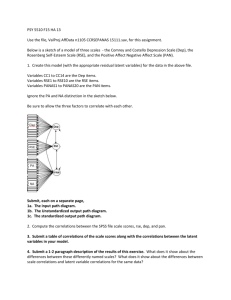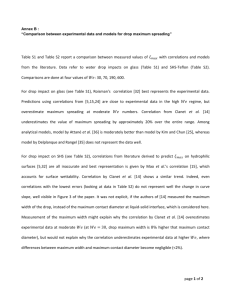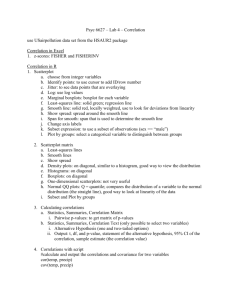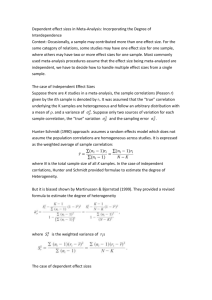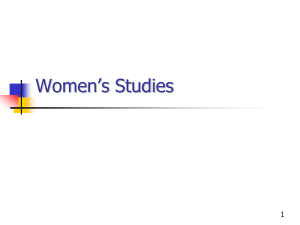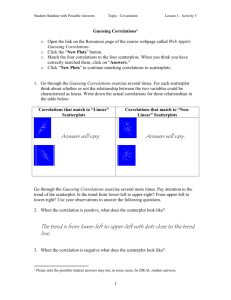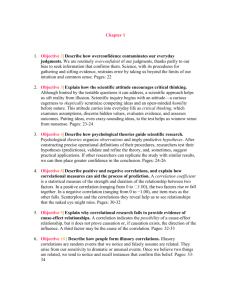anticipating correlations - Manchester Business School
advertisement
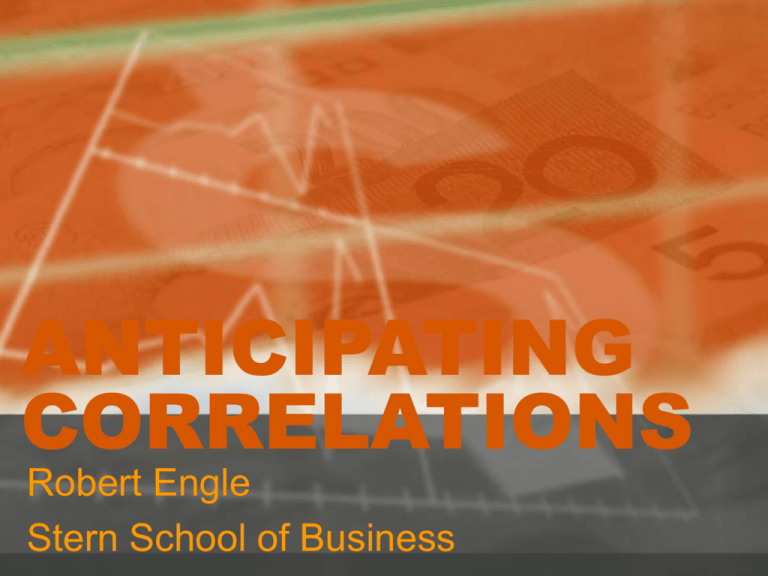
ANTICIPATING CORRELATIONS Robert Engle Stern School of Business Correlation • Correlations for Life – What is the correlation between thunder and rain? – What is the correlation between exercise and health? – What is the correlation between happiness and good food? Correlations for Risk • Stock returns are correlated • Stocks in one country are correlated with stocks in another • Bond returns on one firm or country or maturity are generally correlated with returns on others • But stock and bond returns sometimes appear uncorrelated • The risk of a portfolio is greater if all the assets are highly correlated. It may go down (or up) further, if they all move together. QUOTATIONS • “It is not the biggest, the brightest or the best that will survive, but those who adapt the quickest.” Charles Darwin • “The secret of life is to be interested in one thing profoundly and a thousand things well.” Henry Walpole • “Studies of high school graduates rarely find any correlation between recognition in high school and recognition thereafter.” ANTICIPATING CORRELATIONS • Can we anticipate future correlations? • How and why do correlations change over time? • How can we get the best estimates of correlations for financial decision making? CORRELATIONS – WHAT ARE THEY? • CORRELATIONS MEASURE THE DEGREE TO WHICH TWO SERIES MOVE TOGETHER • THEORETICAL DEFINITION: Let r1 and r2 be mean zero random variables, then 1,2 E r1r2 E r12 E r22 , and E r1r2 1,2 E r12 E r22 4 3 3 2 2 1 1 Y_50 Y_00 4 0 0 -1 -1 -2 -2 -3 -3 -4 -4 -4 -3 -2 -1 0 1 2 3 4 -4 -3 -2 -1 1 2 3 4 1 2 3 4 X 4 4 3 3 2 2 1 1 Y__50 Y_90 X 0 0 0 -1 -1 -2 -2 -3 -3 -4 -3 -2 -1 0 X 1 2 3 4 -4 -3 -2 -1 0 X .15 AXP .05 .00 -.05 -.10 -.15 .15 .10 JPM .05 .00 -.05 -.10 -.15 .20 .15 .10 INTC 10 YEARS OF LARGE CAP STOCKS .10 .05 .00 -.05 -.10 -.15 .2 AXP MSFT JPM .1 .0 -.1 INTC -.2 .12 MSFT .08 MRK MRK .04 .00 -.04 -.08 -.12 -.15 -.10 -.05 .00 AXP .05 .10 .15 -.15 -.10 -.05 .00 JPM .05 .10 .15 -.15 -.10 -.05 .00 .05 INTC .10 .15 .20 -.2 -.1 .0 MSFT .1 .2 -.15 -.10 -.05 .00 MRK .05 .10 DAILY CORRELATIONS AXP JPM INTC MSFT MRK AXP JPM INTC MSFT MRK 1.000000 0.554172 0.285812 0.283375 0.224685 0.554172 1.000000 0.318260 0.310113 0.228688 0.285812 0.318260 1.000000 0.551379 0.130294 0.283375 0.310113 0.551379 1.000000 0.186004 0.224685 0.228688 0.130294 0.186004 1.000000 T3 MONTH T5 YRRET T20 YRRET CAN$ POUND$ AUS$ YEN$ SP500 T3MONTH 1.000 0.329 0.206 0.011 0.076 0.025 0.031 -0.031 T5YRRET 0.329 1.000 0.875 -7E-04 0.136 0.007 0.005 -0.057 T20YRRET 0.206 0.875 1.000 0.007 0.103 -0.002 -0.049 -0.016 CAN$ 0.011 -7E-04 0.007 1.000 0.117 0.415 0.145 0.015 POUND$ 0.076 0.136 0.103 0.117 1.000 0.253 0.224 -0.018 AUS$ 0.025 0.007 -0.002 0.415 0.253 1.000 0.269 0.040 YEN$ 0.031 0.005 -0.049 0.145 0.224 0.269 1.000 -0.003 SP500 -0.031 -0.057 -0.016 0.015 -0.018 0.040 -0.003 1.000 WEEKLY EQUITY CORRELATIONS 1987-2002 US US ITALY FRANCE JAPAN ITALY FRANCE JAPAN HONG KONG 0.223 0.465 0.223 0.308 0.537 0.237 0.269 0.340 0.347 0.229 WHY DO WE NEED CORRELATIONS? WHY DO WE NEED CORRELATIONS? • CALCULATE PORTFOLIO RISK • FORM OPTIMAL PORTFOLIOS • PRICE, HEDGE, AND TRADE DERIVATIVES DIVERSIFICATION • Diversified portfolios have lower variance and risk because some assets go one direction while others go the opposite. • There are many thousands of possible stocks, bonds and other assets to invest in. Can we reduce the risk to zero? • Clearly not. Assets are not uncorrelated. PORTFOLIO RISK • Portfolio risk depends upon the volatilities and correlations of all the components. • For weights w and covariance matrix Omega w ' w 2 P FINDING THE OPTIMAL PORTFOLIO • Minimize portfolio variance subject to a required return. “The Markowitz Problem” With covariance matrix and expected excess returns above a riskless rate of min w ' w s . t . w ' 0 w 0 1 ' 1 ARE CORRELATIONS TIME VARYING? • YES • WHY? – Because the business practice of the companies changes – Because shocks to the economy affect all businesses – Because shocks to one part of the economy will affect only some businesses CONDITIONAL CORRELATIONS • DEFINE BOTH COVARIANCES AND VARIANCES CONDITIONAL ON CURRENT INFORMATION 1,2,t Et 1 r1,t r2,t Et 1 r1,2t Et 1 r22,t ESTIMATION • HISTORICAL CORRELATIONS – Use a rolling window of N observations for both covariances and variances. We will use 100 days. • DYNAMIC CONDITIONAL CORRELATION or DCC – Estimates conditional correlations by first adjusting for differing variances and then updating correlations as new information is received. 100 day historical correlations between AXP and GE .9 .8 .7 .6 .5 .4 .3 .2 .1 .0 94 95 96 97 98 99 00 01 C100_AXP_GE 02 03 04 GENERAL ELECTRIC PROFITS CHANGING EXTERNAL EVENTS • CONSIDER FORD AND HONDA IN 2000 • CORRELATIONS MAY HAVE CHANGED BECAUSE OF CHANGING ENERGY PRICES. 10.0 5.0 4.0 3.0 2.5 2.0 1.5 1.0 0.5 1990 1992 1994 1996 1998 2000 2002 2004 FNBEFORE HNBEFORE EXTEND GARCH CONFIDENCE INTERVALS 50.0 30.0 20.0 15.0 10.0 5.0 3.0 2.0 1.5 1.0 0.5 1990 1992 1994 1996 1998 FNBEFORE HNBEFORE FNUP 2000 2002 FNDOWN HNUP HNDOWN 2004 50.0 30.0 20.0 15.0 10.0 5.0 3.0 2.0 1.5 1.0 0.5 1990 1992 1994 FNBEFORE HNBEFORE FNUP 1996 1998 2000 FNDOWN HNUP HNDOWN 2002 2004 FNAFTER HNAFTER IMPLICATIONS • On Jan 1 2000 the market prices of Ford and Honda reflected the best analysis of the financial markets – What would happen to energy prices? – What would happen to the economy? – What choices would management make? • Five years later, Ford stock was down and Honda was up. • The market rewarded the company that was prepared for higher energy prices. HISTORICAL CORRELATIONS .6 .5 .4 .3 .2 .1 .0 -.1 -.2 -.3 1990 1992 1994 1996 1998 2000 2002 2004 2006 C100_FORDR_HONDAR USE SOME KIND OF MODEL • ONE FACTOR MODEL • MANY FACTOR MODEL • MULTIVARIATE GARCH • DYNAMIC CONDITIONAL CORRELATION MULTIVARIATE MODELS Dynamic Conditional Correlation • DCC is a new type of multivariate GARCH model that is particularly convenient for big systems. See Engle(2002) or Engle(2005). DYNAMIC CONDITIONAL CORRELATION OR DCC 1. Estimate volatilities for each asset and compute the standardized residuals or volatility adjusted returns. 2. Estimate the time varying covariances between these using a maximum likelihood criterion and one of several models for the correlations. 3. Form the correlation matrix and covariance matrix. They are guaranteed to be positive definite. HOW IT WORKS • When two assets move in the same direction, the correlation is increased slightly. • This effect may be stronger in down markets (asymmetry in correlations). • When they move in the opposite direction it is decreased. • The correlations often are assumed to only temporarily deviate from a long run mean • UPDATING IS THE CENTRAL FEATURE CORRELATIONS UPDATE LIKE GARCH • Approximately, t 1,t 1 2,t 1 t 1 1 DCC Correlations AXP and GE .9 .8 .7 .6 .5 .4 .3 .2 .1 .0 95 96 97 98 99 00 01 C9_AXP_GE 02 03 04 .9 .8 .7 .6 .5 .4 .3 .2 .1 .0 95 96 97 C100_AXP_GE 98 99 00 01 C4_AXP_GE 02 03 04 C9_AXP_GE FACTOR MODELS • One or more factors influence all assets • Some assets are more affected by a particular factor than others • Sometimes the factors have little volatility and therefore have little influence ONE FACTOR ARCH • One factor model such as CAPM • There is one market factor with fixed betas and constant variance idiosyncratic errors independent of the factor. The market has 2 some type of ARCH with variance m ,t. ri ,t i rm ,t e i ,t i ,i ,t i2 m2 ,t i • If the market has asymmetric volatility, then individual stocks will too. MARKET VOLATILITY .030 .025 .020 .015 .010 .005 .000 94 95 96 97 98 99 00 01 02 Conditional Standard Deviation 03 04 CALCULATE DYNAMIC CORRELATIONS t 2 1 1 2 m2 ,t 2 m ,t 2 1 2 2 2 m ,t 2 2 • When market volatility is high then correlations are high. The market/economy in general influences both stocks positively. AXP AND GE AGAIN .9 .8 .7 .6 .5 .4 .3 .2 .1 94 95 96 97 98 99 00 01 C4_AXP_GE 02 03 04 CORRELATION OF EXTREMES • How correlated are extreme returns? • Bankruptcy is an extreme event and corresponds to an extremely large negative stock return over a period of time. • Are bankruptcies correlated? CREDIT RISK APPLICATION • This one factor model is the basis of a new credit risk model that I have been developing with a graduate student and hedge fund quant. • How correlated are loan defaults? • When the aggregate market is very low, the probability of default is greater for all companies. When it is high, the probability of default is low for all companies. Hence defaults are correlated and the distribution of market returns tells how much. ASYMMETRY IN MARKET RETURNS • Aggregate market returns have negative skewness, particularly for long horizon returns. Elsewhere I have shown that this is due to asymmetric volatility. • Negative skewness in market returns means that large declines can happen with the associated credit events. EXAMINING THE ONE FACTOR MODEL OF CORRELATIONS HOW WELL DOES THIS WORK? • Examine 18 large cap stocks in the US. • Calculate correlations either historically or with Dynamic Conditional Correlation (DCC) • Relate these correlations to the volatility of S&P500. • Does High market volatility mean high correlation? RESULTS PLOT • About 30 Correlations of these large cap stocks on left axis • Estimated with DCC not using market data • Compare with a GARCH of the S&P500 plotted on right axis .024 .020 S&P volatility .016 1.2 .012 0.8 .008 .004 0.4 0.0 Correlations -0.4 94 95 96 97 98 99 00 01 02 03 04 MEAN CORRELATION AND MARKET VOLATILITY .032 .50 .028 .45 .024 .40 .020 .35 .016 .30 .012 .25 .008 .20 .004 .15 .000 .10 94 95 96 97 98 99 MEANCOR9F 00 01 02 03 V9F_SPRET 04 REGRESSION • • • • • • • • • • • • • Dependent Variable: MEANCOR9F Method: Least Squares Date: 09/10/06 Time: 20:00 Sample: 1/04/1994 12/31/2004 Included observations: 2770 Variable Coefficient Std. Error t-Statistic C V9_SPRET 0.176566 9.600815 0.003343 0.296987 52.81508 32.32740 REGRESSION IN DIFFERENCES • • • • Dependent Variable: D(MEANCOR9F) Method: Least Squares Date: 09/09/06 Time: 11:37 Sample (adjusted): 1/06/1994 12/31/2004 • Included observations: 2768 after adjustments • Convergence achieved after 4 iterations • Newey-West HAC Standard Errors & Covariance (lag truncation=8) • • • • • • • • • Variable Coefficient Std. Error t-Statistic Prob. C D(V9F_SPRET) AR(1) -2.57E-06 7.755417 0.070129 9.18E-05 -0.028054 0.9776 0.612757 12.65660 0.0000 0.023881 2.936653 0.0033 FINDINGS • MARKET VOLATILITY IS PART OF THE STORY • THE CURRENT DECLINE IN MARKET VOLATILITY HAS NOT LEAD TO THE EXPECTED DROP IN CORRELATIONS. ANTICIPATING CORRELATIONS • FORECASTING FACTOR VOLATILITIES IS PART OF THE ANSWER • HOW CAN WE MAKE THIS WORK BETTER? • Research Agenda! – Build DCC models on the residuals – Build Factor DCC models HOW DO WE FORECAST FACTOR VOLATILITIES? • USE GARCH MODELS OR SIMILAR MODELS FOR SHORT RUN FORECASTS. • USE NEW MULTI-COUNTRY RESULTS USING THE SPLINE GARCH FOR LONG RUN MACRO BASED FORECASTS. SPLINE GARCH FOR LOW FREQUENCY VOLATILITY AND ITS MACROECONOMIC CAUSES • Engle and Rangel • Model the daily volatility of many country equity returns • Extract a low frequency component using the spline • Model how this component depends on the macroeconomy S&P500 1.2 1.0 0.8 0.6 0.4 0.2 0.0 60 65 70 75 CVOL 80 85 90 UVOL 95 00 MULTIPLE REGRESSIONS emerging transition log(mc) log(gdpus) nlc grgdp gcpi vol_irate vol_gforex vol_grgdp vol_gcpi All Countries 0.0376 ( 0.0131 )** -0.0178 ( 0.0171 ) -0.0092 ( 0.0055 )* 0.0273 ( 0.0068 )** -1.8E-05 ( 5.4E-06 )** -0.1603 ( 0.1930 ) 0.3976 ( 0.1865 )** 0.0020 ( 0.0008 )** 0.0222 ( 0.0844 ) 0.8635 ( 0.1399 )** 0.9981 ( 0.3356 )** Time Effects 0.25 0.2 0.15 0.1 0.05 0 1990 1994 1998 2002 ANTICIPATING CORRELATIONS • To forecast correlations, we must forecast the volatility of the factors that influence the companies. • When volatility is forecast to be high, then correlations will be high. • Inflation, slow growth, macroeconomic instability forecast high market volatility. • This does not work well when companies are changing their business. May need to update residual correlations using factor DCC.
